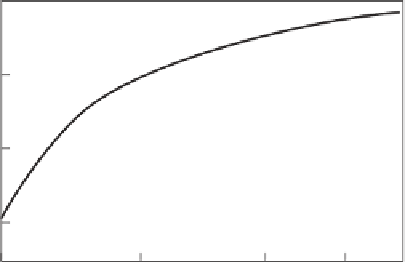Environmental Engineering Reference
In-Depth Information
(in the case of a generator), provided that the magnetic field
B
maintains its direction. Various
forms of armature and magnetic field circuits give rise to the several types of alternating current
and direct current motors and generators.
The AC synchronous generator in an electric utility power plant rotates at a precise speed so
as to produce 60-cycle AC power. All power plants that feed into a common transmission line must
adhere to the same frequency standard. Because generators have an integral number of magnetic
poles, their rotational speeds are an integral submultiple of 60 Hz. The generators maintain a fixed
voltage in the transmission and distribution systems, while the current varies to suit the power
needs of electricity customers.
Because of electrical and mechanical losses in electric motors and generators, the output power
is less than the input power. The ratio of the output to the input powers is the efficiency
η
of the
device,
output power
input power
η
≡
(4.5)
According to the first law of thermodynamics, the difference between the input and output powers
appears as a heat flow from the device to the environment, in the amount of
times the input
power. Both electric motors and generators must be cooled when operating in order to prevent the
overheating of internal parts.
The electrical resistance
R
of the armature wire is a source of inefficiency in both generators
and motors. The electrical power lost in overcoming this resistance,
I
2
R
, increases as
I
2
whereas
the power increases as
I
, as in equation (4.3). This electrical loss thereby becomes a larger fraction
of the power output as the latter is increased. As a consequence, the electrical efficiency of motors
and generators is least at full power. For economic efficiency we would like to obtain the maximum
power for a given investment, which means operating at maximum power and, therefore, least
electrical efficiency.
The efficiency of electric motors and generators is greater for large than for small machines.
Figure 4.4 exhibits this increase of efficiency with size for energy-efficient induction motors. The
(
1
−
η)
96
92
88
84
2
10
40
100
200
Horsepower
Figure 4.4
The efficiency of energy-efficient induction motors as a function of motor power. (Data from
Andreas, John C., 1992.
Energy-Efficient Electric Motors,
2nd edition. New York: Marcel Dekker.)

